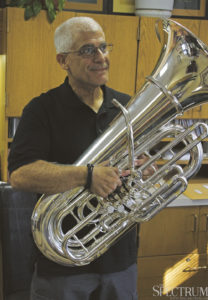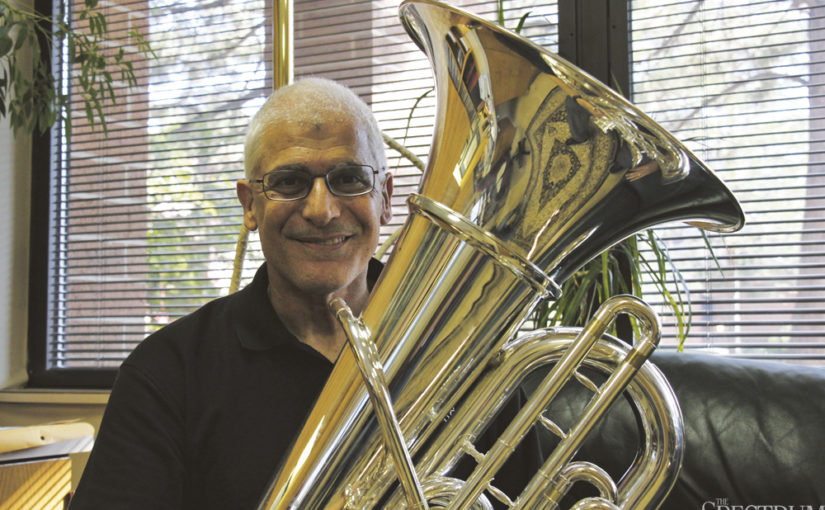
After an extensive 44-year career, award-winning musician Sam Pilafian came to NDSU to bring his idea of inclusive education to the Challey School of Music.
What is the next move for an accomplished musician after 44 years of teaching, touring around the world and working on Broadway and for commercials?
For Dr. Sam Pilafian, it meant coming to NDSU to complete one last “assignment”— what would happen if a college broke down its barriers and blurred the lines between majors? Would students across the college feel more connected? Would there even be enough courses in common to allow for the mixing of students?
According to the results thus far, Pilafian says yes.
Pilafian began his road toward a career in music while growing up in the music melting pot of Miami, Florida. His first instrument was the accordion, an instrument prevalent in the traditional music of his Armenian heritage, which he played at an accordion school.
It wasn’t until he had the opportunity to join the school band, however, that he was introduced to the instrument that would lead to a prestigious and varied career: the tuba.
Pilafian admits it was kind of on impulse that he decided on the instrument: “The day before (selecting an instrument), I had been in a Fourth of July parade and I saw these big shiny tubas in the band, and I thought I’ve got to check these out. See if I can hold one.”
The tuba is generally not an instrument people actively seek out to play on their own, so you can probably imagine how elated Pilafian’s music teacher was to have a volunteer.
“He told me if you play tuba you’ll always have friends,” Pilafian said. “It was true because they (bands) always needed one.” His dedication to mastering the tuba gained him many illustrious awards and recognitions and opened many doors for his career.
Pilafian has managed to amass a very impressive career in music. At the end of high school, he became only the second tuba player in over 55 years to win the National Music Camp’s Concerto contest. By 21, he had graduated college and was already working on Broadway, in television shows and teaching his first class at the sought after Berklee College of Music.
“I met a whole lot of people that were intensely into it (music), and I had to learn how to teach them,” he explained. “There were masterful older teachers that became my mentors.”
Throughout his career, Pilafian has also held teaching positions at Boston University, Arizona State University and the University of Miami, before retiring from teaching in the spring of 2014.
During the first half of his teaching career, he was a member of the world-renowned “Empire Brass,” with whom he toured the world, often bringing back what he had learned to his students. Shortly before retirement, he also had the opportunity to fill a vacant position in the five-piece band, “The Boston Brass,” which was comprised of former students of his. He currently tours with them and teaches master classes.
So, what is he doing here at NDSU?
For three days a month, he acts as a visiting teacher for a project of his that he has deemed his “last assignment.”
His idea was to take an entire music school and blur the lines of majors to create unity among the students.
“(I) found all the commonalities in that school,” Pilafian said. “For example, everyone in music school needs to go as far as possible with their listening skills, their ability to hear and imagine music. So what if you worked with a school across the departments and had projects that involved the whole school?”

From Boston University to Arizona State and the University of Miami, Sam Pilafian is bringing his teaching model to NDSU to blur the lines between majors, especially in the Challey School of Music.
On a recent visit to NDSU, he shared his idea with Robert Challey, the man whom the Challey School of Music is named after, and Challey encouraged him to come to NDSU and put his plan into action. NDSU seemed like a great fit, as it was not only the perfect size, but also possessed an exciting atmosphere and willing staff.
After approaching the director, Dr. John Miller, about trying out his idea here, Pilafian was thrilled they agreed.
“For three years we will be working on the entire school in the fine arts area,” he said. “I also have been working, very happily, with theater people as well.”
The project also includes some summer school. Due to Pilafian’s diverse range of talents — from producing to composing to playing — he finds himself teaching many different subjects in a given day. He’s taught actors how to breathe better in order to talk to the back of the room, rhythm in a choir class and even musical academic classes like the Theory of Music. He also encourages memorization of multiple songs of different style for musicians, as it helps develop their taste in music, as well as makes them think critically and creatively about how a piece could be improved.
Pilafian has found the diverse range of students in each class very promising for the project thus far.
“Now, instead of being a building that celebrates differences, we celebrate commonalities … the benefits of becoming a close-knit group of artists has to pay off,” he said. “We are seeing now the students are breaking down walls and beginning to collaborate, as well. So, instead of someone being know as that tuba player, or that actor, they have a name now. And where it is most evident now is at the beginning of school is in the coffee line. Everybody knows everybody and that’s a good thing.”
The program is not only meant to break down walls, but also to show students how a unique blend of career is possible.
“What’s the most satisfying to me in this whole project, is that the ability to be walking to the lobby or the student union and somebody will walk with you with a question of where the intersection is between two classes, because they experienced it in one day. Questions about recombining information.”
The faculty are planning on tracking the careers of the musicians in this program to see what effects this style of teaching has had on their career path and create a publication about it down the road.
To learn more about the Challey School of Music, visit their page on the NDSU website.
